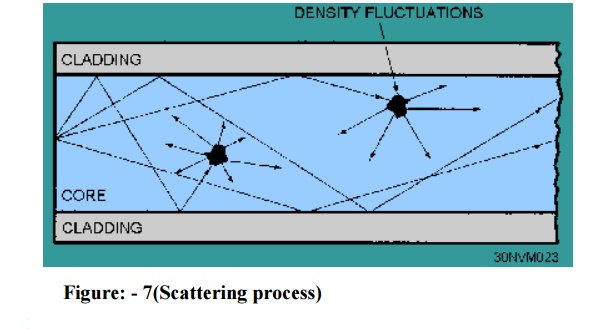Chapter: Fiber optics and Laser instruments : Optical Fiber and Their Properties
Scattering losses
Scattering losses
Basically, scattering losses are caused by the
interaction of light with density fluctuations within a fiber. Density changes
are produced when optical fibers are manufactured. During manufacturing,
regions of higher and lower molecular density areas, relative to the average
density of the fiber, are created. Light traveling through the fiber interacts
with the density areas as shown in Light is then partially scattered in all
direction.

In commercial fibers operating between 700-nm and
1600-nm wavelength, the main source of loss is called Rayleigh scattering. As the wavelength increases, the loss caused
by Rayleigh scattering decreases. If the size of the defect is greater than
one-tenth of the wavelength of light, the scattering mechanism is called Mie scattering.
1. Linear scattering losses
1. Rayleigh scattering
It occurs because the molecules of silicon dioxide have some freedom when adjacent to one another. Thus, setup at irregular positions and distances with respect to one another when the glass is rapidly cooled during the final stage of the fabrication process. Those structural variations are seen by light as variations in the refractive index, thus causing the light to reflect – that is, to scatter – in different directions
Rayleigh scattering is a scattering of light by particles much smaller than the wavelength of the light, which may be individual atoms or molecules. Rayleigh scattering is a process in which light is scattered by a small spherical volume of variant refractive index, such as a particle, bubble, droplet, or even a density fluctuation.
As light
travels in the core, it interacts with the silica molecules in the core.
Rayleigh scattering is the result of these elastic collisions between the light
wave and the silica molecules in the fiber. Rayleigh scattering accounts for
about 96 percent of attenuation in optical fiber
Causes of
Rayleigh Scattering:
It
results from non-ideal physical properties of the manufactured fiber.
It
results from inhomogeneities in the core and cladding.
Because
of these inhomogeneities problems occur like –
a) Fluctuation
in refractive index
b) density
and compositional variations.
Minimizing of Rayleigh Scattering:
Rayleigh
scattering is caused due to compositional variations which can be reduced by
improved fabrication.
Equation of Rayleigh Scattering:
Light
scattering can be divided into three domains based on a dimensionless size
parameter, α which is defined as
A = πDp / λ
where πDp is the circumference(The
boundary line of a circle) of a particle and λ is the wavelength of incident
radiation. Based on the value of α, these domains are:
α<<1:
Rayleigh scattering (small particle compared to wavelength of light) α≈1: Mie
scattering (particle about the same size as wavelength of light)
2. Mie scattering
Non
perfect cylindrical structure of the fiber and imperfections like
irregularities in the core-cladding interface, diameter fluctuations, strains
and bubbles may create linear scattering which is termed as Mie scattering
Mie scattering is a
scattering of light by particles approximately equal to the wavelength of the light, which may be individual atoms or
molecules.
Causes of Mie Scattering:
Occurred
due to inhomogeneities in the composition of silica. (i.e. inhomogeneities in
the density of SiO2 )
Irregularities
in the core-cladding interface, Difference in core cladding refractive index,
Diameter fluctuations
Due to
presence of strains and bubbles.
The
scattering caused by such inhomogeneities is mainly in the forward direction
depending upon the fiber material, design and manufacture.
Minimizing of Mie scattering
Mie
scattering is mainly caused by inhomogeneities which can be minimized by
Removing
imperfection due to glass manufacturing process
Carefully
controlled extrusion(To push or thrust out) and coating of the fiber
Both Mie
and Rayleigh scattering are considered elastic scattering (elastic scattering
is also called Linear scattering) processes, in which the energy (and thus
wavelength and frequency) of the light is not substantially changed.
2. Nonlinear scattering losses
Specially
at high optical power levels scattering causes disproportionate attenuation,
due to non linearbehavior. Because of this non linear scattering the optical
power from one mode is transferred in either the forward or backward direction
to the same, or other modes, at different frequencies. The two dominant types
of non linear scattering are :
a) Stimulated
Brillouin Scattering and
b) Stimulated
Raman Scattering.
a) Stimulated Brillouin Scattering:
This is
defined as the modulation of light through thermal molecular vibration within
the fiber. The scattered light contains upper and lower side bands along with
incident light frequency. An incident photon produces a scattered photon as
well as a photon of acoustic frequency. The frequency shift is maximum in the
backward direction and it is reduced to zero in the forward direction. The
threshold optical power for Brillion scattering is proportional to
d2λ2αB
b) Stimulated Raman Scattering:
Here, the
scattered light consists of a scattered photon and a high frequency optical
photon. Further, this occurs both in the forward and backward direction in the
optical fiber. The threshold optical power for Raman scattering is about three
orders of magnitude higher than the Brillouin threshold for the given fiber,
The threshold optical power for Raman scattering is proportional to
d2λ2αR
Related Topics